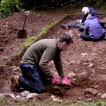The Excavation
We opened up three trenches. Trench 1 was dug outside the enclosure, to the south where many of the finds came from. It was 2m wide and 19m long (it was meant to be 20m, but there was a tree-stump at either end). A wall ran east-west across it at its southern end with rubble on either side. It looked as though the foundation trench for the wall may have been cut through the rubble, but after the foundations had been built, the rest of the trench was backfilled with the same rubble and we couldn´t see any difference until we studied the section and could see how the individual stones were angled. To the south of the wall, the rubble overlay a deposit of burnt clay, but there wasn´t enough time for us to uncover this properly. Underneath the rubble on the north side of the wall, we could see that there was a cobbled surface, but again we were not able to trace exactly how far it extended apart from seeing that it didn´t continue far into the northern half of the trench.
Trenches 2 and 3 were the same size, 2m x 5m. Trench 3, dug inside the enclosure, revealed only spreads of stone. These may have included a very ruined wall, but it was not really possible to make sense of them. Interestingly, a number of Neolithic flints came from this part of the site — they must have been left there at about the same time as the Neolithic tomb was being built an used in the bottom of the valley almost directly below.
Trench 2 was dug through the bank on the south side of the enclosure. One of the thins we wanted to investigate was how much damage had been done by vehicles driving along the track. It turned out that they had not done too much damage. Once the rubble had been removed, we could see the bank clearly. We initially thought that there was a well-marked wall on the inside edge because we had a line of stones, but this turned out to be just on the surface, and there was no clear edge to the bank on this side. The outer edge of the bank was better defined, with a drystone wall. The middle part of the bank was a loose filling of earth and stones. The bank contained Roman pottery and tile, showing that our first idea — that it was an Iron Age enclosure with later Roman occupation — was wrong. We now think that the enclosure was built on top of the Roman site, making use of rubble that had come from ruined Roman-period walls.
More Roman pottery, brick and tile was found in all the trenches. There were also animal bones, including bones and teeth from deer and wild boar which are not very common on Roman sites. We also found a lot of oystershells in Trench 2. They may have been dumped in a ditch, but we didn´t have enough time to excavate all of this deposit and find out for sure. The date of the pottery suggests that the site was mainly occupied in the 2nd-3rd centuries.






